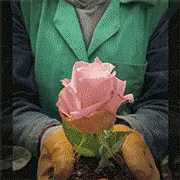AIPH; The International Association of Horticultural Producers held its spring meeting here on Miami Beach in March.
I was invited to attend, and I share my thoughts on the first day of presentations.
To begin, the event was not fully attended due to coronaavirus issues which are affecting International business worldwide.
After attending a few of these European based organizations gatherings I am always shocked at that lack of participation from the American Floral industry. Perhaps tomorrow there will be some more in attendance when Anna Ball, Ball Horticulture; Kate Penn, SAF; and Chrsitine Bolt, AFIF; will be presenting.
There were two themes discussed today: Garden tourism events and Green cities.
In case you thought there were already too many Flower/Flora expos, hang on, because the world is eager to host more of these events.
We heard presentations from representatives of South Korea, Myanmar, Brazil, Moscow, and Poland. These countries were here promoting their shows or seeking approval from AIPH to have their support.
It is interesting to note that the governments of many Asian counties highly subsidize these events to promote their image in the world. What better way than with flowers and all things green.
These events are large outdoor exhibitions that gather together growers, designers, governments, and other invested parties to host these, often months long, events. Most are open to the public and some are hosted by private organizations that charge an entry fee.
Keukenhof in the Netherlands is one of the most well-known and is held from March 21 till May 10 and is open to the public and worth your time to visit.
Most events are landscape and design wonderlands and are often held in conjunction with an indoor floral expo.
Garden tourism is just what is sounds like. People will travel to places where they can get the full experience of being surrounded by nature.
IBO Gulsen of Managing director of IGMPR “Imagineering Horti Culture” offered a good history lesson in Gardens. Perhaps we all remember from school, the talk of Ancient gardens in Turkey, Babylon, Venice, Italy, and many other cities and cultures that embraced the concept of grand spaces filled with designed nature. There are tours that you can take that will bring you to these places of wonder. There are more than 100 Garden destinations in the world.
Next up was Tim Beatley Professor of Sustainable Communities in the School of Architecture at the University of Virginia.
This was a very interesting presentation regarding Green cities around the world. I found it comforting to know, in this age of climate change, that there are very serious efforts being made by countries, corporations, people, and communities to do something about it.
Here is a new term for you; Biophilic cities. biophiliccities.org connecting Cities and Nature. Perhaps we have all seen some of this concept where office and residential buildings have lush green foliage crawling up the entire building. Roof top gardens, re utilizing wasted urban space, like in NYC where they made an old abandoned elevated train track into a garden and a place where people are welcomed.
Many are starting to understand the value of nature and its effect on us as humans. Listen to the birds sing, watch them fly, and if not too obvious from this writer, Stop and smell the flowers.
The biophilic cities organization has 22 member cities globally that participate in the program and they meet to share ideas, failures and successes.
The next speakers were from Chinese Taipei, Holland, Brazil, South Korea and Canada.
Each told us how their countries are investing in Green. Taipei is planting one million trees. Holland has been using public spaces very creatively for years. Brazil has been tearing up common concrete spaces and planting foliage. They have a program that offers bus fairs in exchange for recyclable materials.
In South Korea they are planting 10 million trees and want to turn “grey into green”,
Bill Hardy Chair of Green City Committee, told us that in Canada the government wanted to plant 2 million trees but he suggested that they only plant 1 million, but to plant them correctly, in urban areas and provide funds to maintain them. Despite best intentions sometimes seedling are planted in rural areas and never cared for with poor results,
In summary it was a very interesting day listening to experts explain why Green is good and how it should become the norm not the exception to our lives on earth.
Williee Armellini
Editor Flowersandcentes.com
williee@localhost




































Leave a Comment